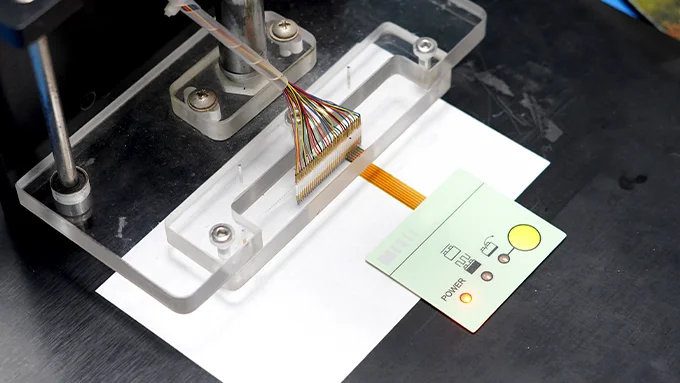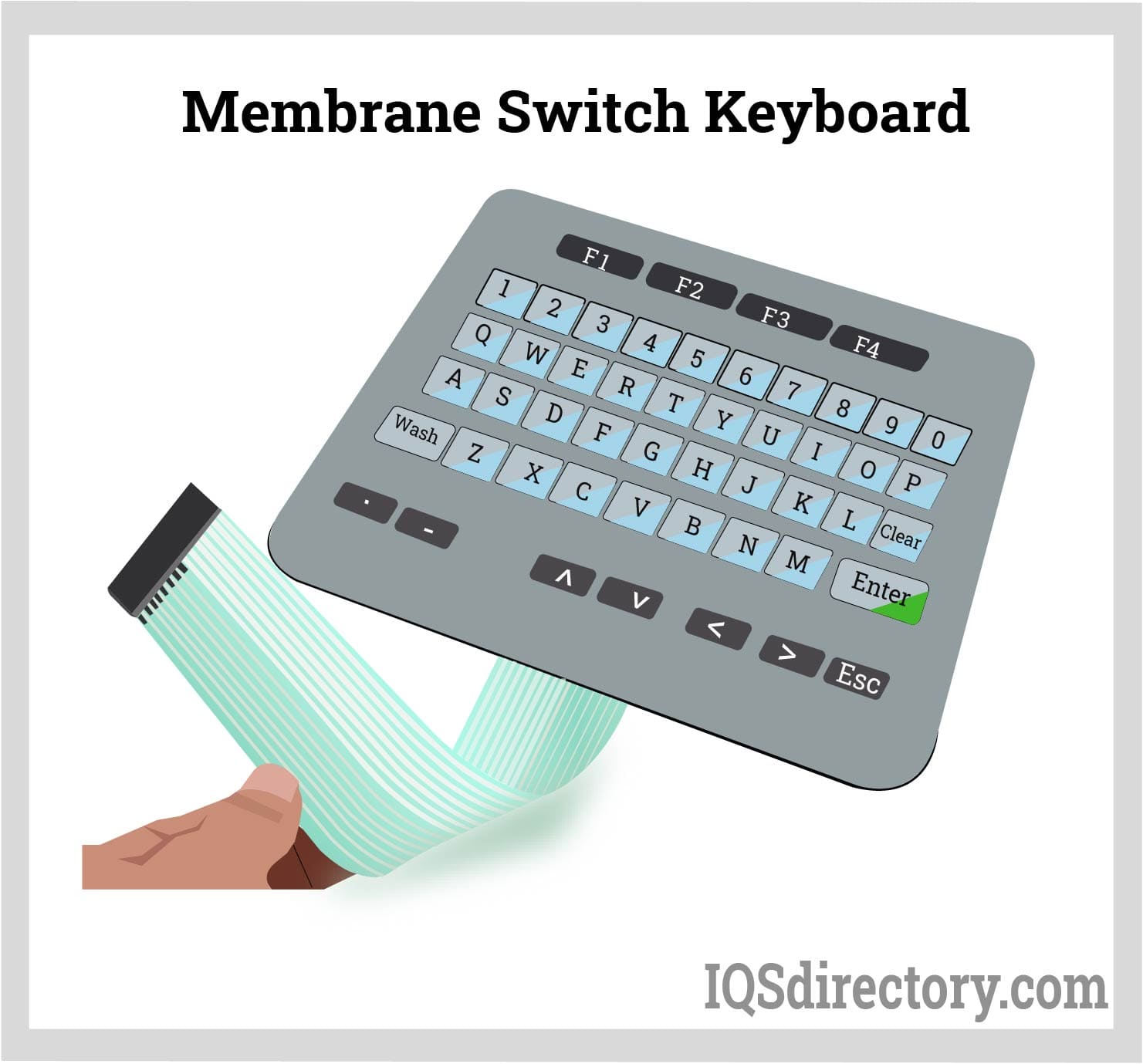The Manufacturing Refine Behind Membrane Switch Over: What You Need to Know
The manufacturing procedure behind membrane switches over combines cautious layout, material option, and quality assurance. It starts with comprehending the complexities of membrane button design and advances through different stages, consisting of material selections and printing techniques. Each stage plays a vital duty in making sure capability and durability. Nonetheless, the complexities of layer building and the strenuous testing requirements might reveal insights that are not immediately evident. What lies beyond these foundational aspects?
Recognizing Membrane Switch Design
Although membrane buttons might show up straightforward at first glimpse, their style involves elaborate factors to consider that assure capability and resilience. The design process begins with an extensive understanding of individual demands, consisting of the interface's designated application and environmental variables. Comfort designs is a crucial element, as the format has to promote convenience of usage while making certain that responsive responses fulfills individual expectations.Moreover, the layering of elements, such as graphic overlays, adhesive layers, and conductive traces, must be specifically engineered. membrane switch. This split arrangement not only affects the button's responsiveness however also influences its longevity. Attention is offered to the securing methods employed to shield versus wetness and dust, which might compromise performance. Additionally, style considerations encompass visual appeals, where color pattern and aesthetic clearness enhance customer experience. Eventually, the design of membrane layer switches over balances capability, individual experience, and sturdiness, guaranteeing that they fulfill the demands of various applications properly
Materials Made Use Of in Membrane Switch Over Manufacturing
When picking materials for membrane layer switch production, it is vital to contemplate both efficiency and resilience. The key materials consist of polyester and polycarbonate films, which supply flexibility and toughness. These films are usually coated with glue to guarantee correct bonding to substrates. Conductive inks, normally made up of silver or carbon, are important for creating electric links within the switch, enabling reliable operation.Additionally, a protective layer, such as a tough layer, is often related to improve scrape resistance and longevity. The option of backing product, such as acrylic or foam, can considerably affect the switch's tactile feel and general customer experience. Various environmental aspects, consisting of temperature level and moisture, should guide material option to guarantee peak performance in particular applications. Eventually, the ideal mix of products adds to the membrane layer button's capability and lifespan, making informed options necessary for suppliers.
The Printing Refine: Creating Video and Text
The printing procedure in membrane switch manufacturing plays a significant role in producing top quality graphics and text. Various graphic design techniques are employed to assure aesthetic allure and capability, while cautious ink selection methods are important for sturdiness and performance. Understanding these elements is basic for attaining finest lead to membrane layer switch design.
Graphic Style Techniques
Graphic design techniques play a crucial duty in the printing procedure of membrane buttons, as they specify how graphics and message will eventually show up on the final item. Reliable visuals design entails the tactical usage of colors, typefaces, and designs to boost readability and aesthetic allure. Developers usually make use of vector graphics for scalability, guaranteeing that images continue to be sharp at numerous sizes. In addition, attention to contrast and placement is essential, as it affects customer interaction and aesthetic high quality. The unification of branding aspects, such as logos, have to be taken care of with care to preserve brand name integrity. On the whole, thoughtful graphic layout techniques contribute substantially to the functionality and beauty of membrane layer buttons, impacting individual experience and item performance.
Ink Choice Approaches
Picking the appropriate ink is necessary for attaining the desired visual high quality and sturdiness in membrane layer button manufacturing. Various ink types are utilized, including solvent-based, water-based, and UV-curable inks. Each type uses distinctive attributes, such as resistance, bond, and versatility to environmental factors. Solvent-based inks are often favored for their sturdiness and vibrant colors, while water-based inks are much more eco-friendly but may have limitations in adhesion. UV-curable inks provide quick healing and durable performance. Furthermore, color matching techniques assure that the picked inks line up with style requirements. Eventually, the selection of ink should think about elements such as application method, substratum compatibility, and end-use needs to attain remarkable lead to membrane button graphics and message.
Layer Building and Assembly

Product Option Refine
A careful selection of materials is crucial in the manufacturing process of membrane switches, as it directly influences functionality and resilience. The primary materials used include polyester, polycarbonate, and numerous conductive inks. Polyester is usually preferred for Going Here its excellent resistance to chemicals and abrasion, making it ideal for harsh settings. Polycarbonate, on the various other hand, gives premium quality and impact resistance, which is advantageous for applications needing visibility and robustness. Conductive inks, typically made up of silver or carbon, are essential for developing trustworthy electric pathways. Furthermore, the option of sticky materials impacts the total stability of the switch - membrane switch. Evaluating factors such as ecological direct exposure, responsive comments, and aesthetic needs guides producers in picking the very best materials for their specific applications
Layer Attachment Methods
Adhering layers in membrane layer switch construction is an essential process that guarantees capability and durability. Various bond techniques are used to secure ideal bonding in between layers, which generally consist of the use of adhesives, warmth, and pressure. Pressure-sensitive adhesives (PSAs) are generally used for their ease of application and instant bonding capacities. Furthermore, thermal bonding techniques can be applied, where warmth is utilized to turn on sticky properties, safeguarding a strong bond. The option of attachment method mainly depends on the products involved and the certain application requirements of the membrane button. Proper placement and uniform application of adhesives are crucial to avoid issues, securing the switch runs effectively throughout its designated life-span.
Quality Assurance Measures
Ensuring quality assurance during the layer construction and setting up of membrane layer buttons is important for preserving efficiency and integrity. This process typically includes a number of essential measures, including extensive examinations at each phase of manufacturing. Manufacturers utilize advanced testing techniques, such as peel tests and bond evaluations, to confirm the honesty of layer bonds. In addition, aesthetic examinations are performed to recognize any kind of issues in printing or product incongruities. Ecological problems, such as temperature level go to website and moisture, are meticulously checked to assure excellent treating and bond. Normal calibration of devices assists preserve accurate manufacturing standards. By implementing these top quality control actions, suppliers can considerably decrease the risk of product failure, guaranteeing that the final membrane layer changes fulfill the called for requirements and client expectations.
Testing and Quality Assurance Actions

Advancements in Membrane Layer Switch Over Innovation
As advancements in modern technology proceed to develop, membrane layer switches are gaining from cutting-edge developments that boost their performance and customer experience. One significant development is the assimilation of capacitive touch innovation, which allows for even more intuitive and receptive user interfaces. This change not only improves aesthetics yet also lowers mechanical damage, extending the life expectancy of the switches.Additionally, advancements in visuals overlay materials have led to enhanced durability and resistance to ecological factors such as wetness and UV light. These products now provide boosted clarity and brightness, more elevating the visual appeal.Furthermore, the unification of smart innovation is changing membrane changes right into interactive control board, enabling connectivity with IoT gadgets. This connection fosters a smooth individual experience, leading the way for applications in various markets, from medical care to customer electronics. Collectively, these developments setting membrane layer switches over as crucial components in contemporary tool layout.
Regularly Asked Questions
How Long Does the Membrane Change Manufacturing Process Take?
The duration of the membrane switch manufacturing process can vary significantly. Aspects such as intricacy, products utilized, and manufacturing quantity influence timelines, with normal manufacturing ranging from a few days to several weeks for completion.
What Are the Typical Applications for Membrane Switches?
Membrane buttons are commonly made use of in numerous sectors, consisting of vehicle controls, family home appliances, medical devices, and consumer electronics (membrane switch). Their versatility and durability make them ideal for applications requiring straightforward user interfaces and trustworthy efficiency in diverse environments
Can Membrane Layer Changes Be Personalized for Particular Needs?

What Is the Life expectancy of a Typical Membrane Change?
The life expectancy of a normal membrane layer button differs, however usually, it varies from 1 to 5 million cycles. Variables such as use, environment, and material quality greatly influence sturdiness and general performance gradually.

Are Membrane Layer Changes Eco-friendly?
The environmental kindness of membrane layer changes varies. Some materials made use of might not be recyclable, while others can be environmentally friendly. The general effect depends on producing methods and products, requiring mindful consideration during choice and disposal. The production procedure behind membrane layer switches combines careful design, product choice, and quality control. It starts with comprehending the complexities of membrane layer button design and proceeds with various phases, consisting of material choices and printing methods. When selecting products for membrane button manufacturing, it is important to ponder both performance and durability. A mindful selection of products is important in the production process of membrane layer switches, as it straight influences performance and resilience. The selection of adhesion approach largely depends on the products involved and the certain application requirements of the membrane button.